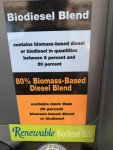williamh
Well-known member
- 514
- 717
- 93
- Location
- SanDiego Ca.
Since I live in so cal. I’ve been seeing a lot of this bio diesel. And found this write up. Thought I’d share it.
If you have a diesel-powered motorhome, or tow vehicle, you are probably used to seeing fuel pumps labeled with biodiesel content. Typically, they are marked with B-5 and up to B20. This is the percentage of the oilseed produced biodiesel that is in the fuel. Like the “E” (Ethanol) that many gasoline pumps dispense, we take little notice. However, the biodiesel may not be that diesel-engine friendly, or in particular, to those diesel-powered RV’s.
First, if you have a Mercedes diesel engine, as many RV’s are now using, you had better read your manual. These engines will operate on up to B-5, but not above. The use of B20 fuel may do serious damage to the motor and may not be covered by the factory warranty.
Newer Cummins engines, say models in the past 10 years, are capable of operating on any biodiesel up to B20. However, there are precautions to observe for the use of B20. Minor issues with possible earlier fuel filter changes are not a big problem. However, layups of three months or more with B20 fuel is another story.
Beware of B20 in Idle Vehicles
We see trucks fueling with this and running without issue. However, they are always working and never parked for an extended time. RV’s, in most cases, are subject to extended periods of non-use. This makes them extremely exposed to internal system damage should B20 fuel be present.
Apparently, the sustainable-farmed fuel is not so friendly to some seal materials and metallic compositions that may be found within the fuel system. Even the injectors can suffer corrosive damage if the solution sits there for an extended period of time.
Biodiesel can be found in many states. The retailers are offered incentives to handle and sell it. B20, for example, may have a substantial tax rebate compared to regular fuel. This has driven fuel retailers to sell these higher percentage biofuels to offer lower prices and increase their profits. In some areas it may be impossible to avoid having to use it.
If you have a diesel-powered motorhome, or tow vehicle, you are probably used to seeing fuel pumps labeled with biodiesel content. Typically, they are marked with B-5 and up to B20. This is the percentage of the oilseed produced biodiesel that is in the fuel. Like the “E” (Ethanol) that many gasoline pumps dispense, we take little notice. However, the biodiesel may not be that diesel-engine friendly, or in particular, to those diesel-powered RV’s.
First, if you have a Mercedes diesel engine, as many RV’s are now using, you had better read your manual. These engines will operate on up to B-5, but not above. The use of B20 fuel may do serious damage to the motor and may not be covered by the factory warranty.
Newer Cummins engines, say models in the past 10 years, are capable of operating on any biodiesel up to B20. However, there are precautions to observe for the use of B20. Minor issues with possible earlier fuel filter changes are not a big problem. However, layups of three months or more with B20 fuel is another story.
Beware of B20 in Idle Vehicles
We see trucks fueling with this and running without issue. However, they are always working and never parked for an extended time. RV’s, in most cases, are subject to extended periods of non-use. This makes them extremely exposed to internal system damage should B20 fuel be present.
Apparently, the sustainable-farmed fuel is not so friendly to some seal materials and metallic compositions that may be found within the fuel system. Even the injectors can suffer corrosive damage if the solution sits there for an extended period of time.
Biodiesel can be found in many states. The retailers are offered incentives to handle and sell it. B20, for example, may have a substantial tax rebate compared to regular fuel. This has driven fuel retailers to sell these higher percentage biofuels to offer lower prices and increase their profits. In some areas it may be impossible to avoid having to use it.
Attachments
-
84.4 KB Views: 11


